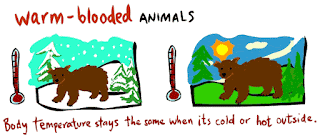The Chordate Phylum
 |
| Source: Encyclopedia Britannica |
Chordates share these characteristics: at some point in their lives, they have a notochord, a nerve cord, and slits in their throat area.
Notochord is a flexible rod that supports the animal's back.
In vertebrates, part or all of the notochord is replaced by a backbone. A few vertebrates have backbones made of cartilage (a connective tissue that is softer than bone, but flexible and strong). Most vertebrates have backbones made of hard bone.
All chordates have a nerve cord that runs down their back.
The nerve cord is the connection between the brain and the nerves.
Chordates have slits in their throat area called pharyngeal slits. Fishes keep these slits as part of their gills for their entire lives, but in many vertebrates, including humans, pharyngeal slits disappear before birth.
The Backbone and Endoskeleton
 |
| Source: Slideplayer |
A vertebrate's backbone is part of an endoskeleton, or internal skeleton. The endoskeleton supports and protects the body, help give it shape, and gives muscles a place to attach. In addition to the backbone, the vertebrate's endoskeleton includes the skull and ribs. The skull protects the brain and sense organs. The ribs attach to the vertebrae and protect the heart, lungs, and other internal organs.
Maintaining Body Temperature
Most fishes, amphibians, and reptiles have a body temperature that is close to the temperature of their environment. In contrast, birds and mammals have a stable body temperature that is typically much warmer than their environment.
ectotherms (cold blooded)
 |
| Source: Sheppard Software's |
An animal whose body does not produce much internal heat - fishes, amphibians, and reptiles.
endotherm (warm blooded)
 |
| Source: Sheppard Software's |
Endotherms also have other adaptations, such as fur or feathers and sweat glands, for maintaining their body temperature.
No comments:
Post a Comment